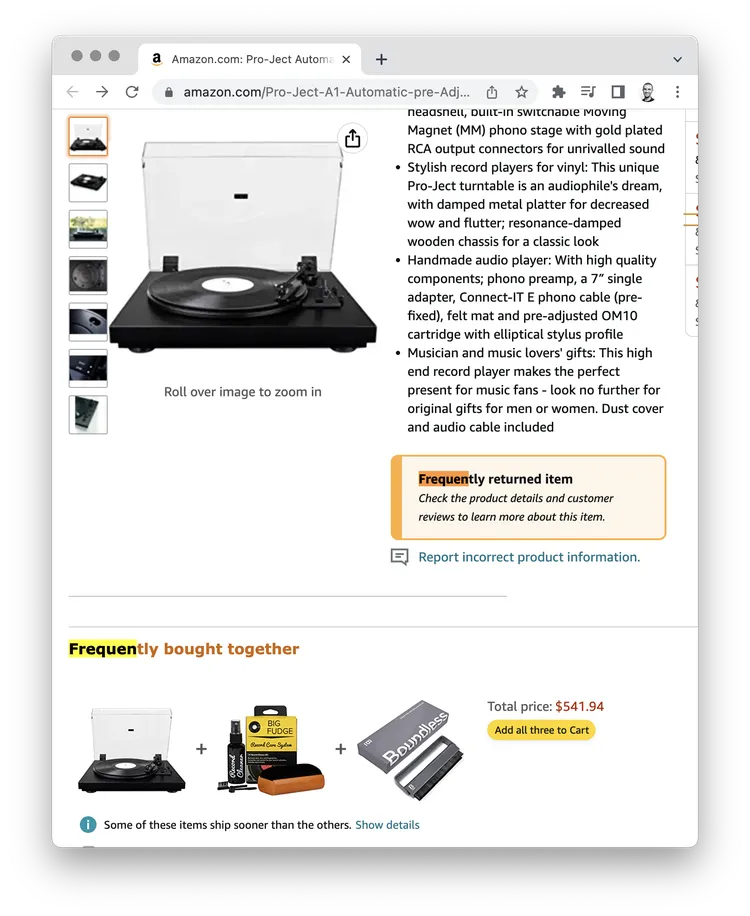With all the work that goes into selling a product on Amazon, each and every sold item feels like an accomplishment, validating each step of your strategy and execution. Due to this, it feels equally as backbreaking when you check Seller Central to discover customers have returned your product. Unfortunately, customer returns are an inevitable part of the Amazon selling journey. High return rates can impact your visibility and customer trust.
However, maintaining a low Amazon return rate is crucial for your seller reputation and profitability. In this article, we’ll explore actionable strategies to help you minimize returns and enhance your overall selling experience on Amazon.
What is Amazon Return Rate?
By definition, your Amazon return rate informs you of how frequently customers return a purchased item. Common culprits for high rates include:
- Inaccurate product descriptions
- Poor quality
- Confusing packaging
- Sizing issues
- Unmet customer expectations
- Shipping damage
- Lack of instructions
- Complex product setup
Remember, a high return rate dings your seller metrics and can bury your listings, resulting in a decrease in your profits.
Across retail, product returns account for $761 billion in lost sales a year and online sales are an increased risk for online purchases, making it a serious danger to your bottom line through lost sales. For a comprehensive breakdown of Amazon’s return policy to understand the customer side, you can visit their official returns and refunds page to cover the basics of what items can and cannot be returned.
Analyze Your Current Return Rate
Every Amazon seller should regularly track their Amazon return percentage and utilize it to inform their broader selling strategy. Although Amazon hasn’t shared the average return rate across the marketplace or by category, a generally accepted Amazon average return rate can range anywhere from 5%-15% and be considered normal and reasonable.
How to View Returns on Amazon
Current sellers on Amazon can examine their current performance and dig through their return rate analysis by following these steps:
- Sign into your Seller Central account
- Hover over the Reports tab
- Click on the Return Reports option on the dropdown menu
Voila! From here, you can view and analyze a number of details about your return management process and how it affects your business and use it to find out how to reduce customer returns. Once you’ve navigated to this page, feel free to check around and dig through the data to gain a better perspective on what information can be found on this page.
Does Amazon look at returns?
Absolutely, never lose sight of the fact that at the core of Amazon’s marketplace, providing a reliably positive consumer experience is their mission. Not only do returns signal lost profits, but they also have a lasting effect on your business. Through organic rank and pay-per-click bids, Amazon continually rewards sellers for delivering satisfactory products and experiences for customers. Products more likely to be returned than competitors for reasons ranging from unsatisfactory quality, slow shipping times, fulfillment errors, and virtually anything that signals it’s less likely to end in a happy customer can hurt you beyond lost revenue.
No matter your return rate, proactively minimizing returns should be a major consideration for running your business. Below, we’ll dig into five proven strategies that can lower your return rate so you can quit losing out on money made due to return costs and maintain healthy profits.
1. Enhance Product Listings
One of the most effective ways to reduce returns is to ensure your product listings accurately represent its capabilities, effectiveness, and presentation. Generally, customers make informed buying decisions, scouring through details to check if it solves their problem and serves an intended purpose.
If your product photos don’t match the actual product customers receive or the product descriptions claim to possess features or benefits it can’t perform, you’re setting yourself up for a high Amazon return dissatisfaction rate. Check out our tips to create winning Amazon product descriptions and guide to Amazon product photography to set yourself up for success and avoid Amazon return problems.
Pro Tip: You can leverage our Listing Builder or Listing Analyzer Tools to enhance your product listings.
2. Improve Product Quality & Packaging

Don’t let shoddy craftsmanship or flimsy packaging be your downfall! Implement strict quality control measures, source from reliable suppliers, and invest in protective packaging that matches your product’s needs so it can work as intended and as expected when it arrives
If you’re unsure of what type of packaging you need, Amazon recommends a 3-foot drop test. This process involves packaging your product as you would for a customer and dropping it six times at different angles for roughly a 3-foot drop. The recommended angles are to drop it on the base, top, longest side, and corner a total of six times to simulate what might happen to your product en route to its destination via a major carrier.
Before implementing the drop test, be sure to check Amazon’s packaging guidelines to ensure it meets the requirements and best practices to avoid refusals due to inadequate or non-compliant packaging.
3. Streamline Customer Service
When customers encounter issues with a product, prompt and helpful customer service can often resolve them before they lead to a return. This could involve troubleshooting technical problems, offering alternative solutions like replacements or repair options, or providing clear return instructions if necessary. By addressing concerns quickly and effectively, good customer service can turn a potentially frustrated buyer into a satisfied one. Even better, you can turn an unsatisfied shopper into a repeat customer if the customer service goes above and beyond to ensure their satisfaction.
Answering customer questions and answers on your listing can add value to your product detail page. If you sell outside of Amazon, setting up an email, chat, or phone number for customers to reach with questions, concerns, or problems can be helpful for limiting returns. When you reply promptly with helpful information, it goes a long way with customers. Approach every customer interaction with the understanding that they trusted you with their purchase and hope to make it worthwhile. By all means, listen to their problems, be empathetic, and explicitly seek to provide a solution for them.
4. Leverage Customer Feedback
When you treat feedback like gold, you can turn losses into lessons and optimize your offering. Actively collect reviews and ratings, but don’t just read them – analyze them. Be sure to keep an eye out for recurring themes as customers identify pain points in reviews and under their reason for returning and use that information to constantly improve your product and listing to reduce return volume. It’s even worthwhile to monitor the positive and negative reviews from competitors in the market
Major companies spend tons of money on consumer feedback and gathering data with the goal of improving customer satisfaction and quality control. As a result of meticulously monitoring customer feedback for your product and product market, you skip the spending while achieving the same goal. To increase the likelihood of receiving customer feedback for purchases, our Amazon Review Generator maximizes your chances of boosting customer reviews, all within Amazon’s terms of service!
Advanced Strategies
In addition to these general rules, consider additional ways to limit reviews and increase satisfaction.
Do The Research
If you’re searching for your first or next item to offer on Amazon, click around on competitor products with a keen eye under the bullet points. In 2023, Amazon began labeling items with an excessive return rate as “frequently returned” in the description. While a frequently returned item could easily be a seller or manufacturer mistake, these warnings can be informative if multiple within a product market receive this tag. Certain product types or products in specific categories are more likely to be returned than others. For example, electronics and fragile items without an abundance of packaging are commonly returned items.

Include As Much Information As Possible in Your Product Description
Amazon ensures a uniform shopping experience for customers. With mandatory style guidelines for images and sections in product descriptions, there isn’t much room to truly personalize your product detail page. Because of this, it’s crucial sellers use every tool at their disposal to inform and educate shoppers about their product.
You can find additional product information near the bottom of most product pages. Within this space, shoppers can see many details that can inform customers what they should expect. From product dimensions and weight to materials to special features, utilizing this space can do your part to make sure customers don’t make a purchase with the wrong expectations.
Make Sure The Price Is Right
Pricing plays a critical factor in managing returns. When customers pay a premium price, they rightfully expect a premium product. If competitors charge a steep price for a product and yours doesn’t have all the bells and whistles, offering your product at a greater cost can be tempting. But picking up sales with a high number of them destined to be returned is a losing game. You may want to consider dynamic pricing to manage expectations and satisfaction, especially if you see an uptick in returns or negative reviews hurting your operations.
Conclusion
Although limiting customer returns is often viewed as an afterthought, taking these steps into consideration can be incredibly rewarding to your bottom line. By implementing these strategies, you can build a customer-centric approach that slashes returns, boosts profits, and keeps your products shining brightly in search results. Like many other aspects of selling on Amazon, adapting your approach and optimizing your offering can pay dividends in the long run.
Viral Launch’s suite of seller optimization tools plays a crucial role in this process by helping sellers understand and implement strategies that can lead to lower return rates. Through detailed analytics, product research, and listing optimization, our tools provide the insights and resources needed to improve product listings, target the right audience, and ensure product quality meets customer standards. These tools have been designed to help sellers create a more satisfying shopping experience, which in turn, reduces returns and drives long-term success on Amazon.








